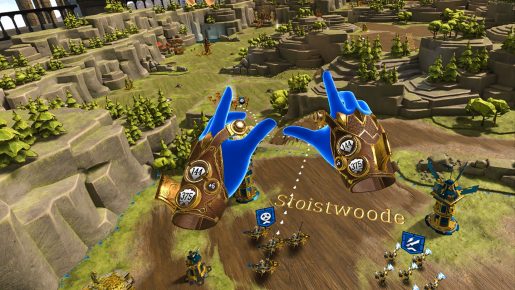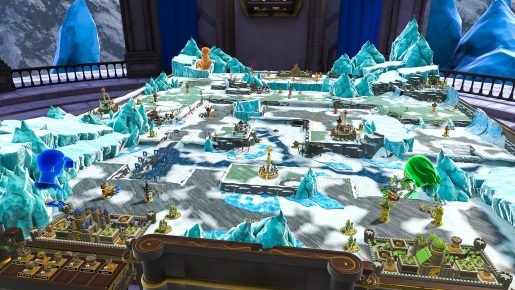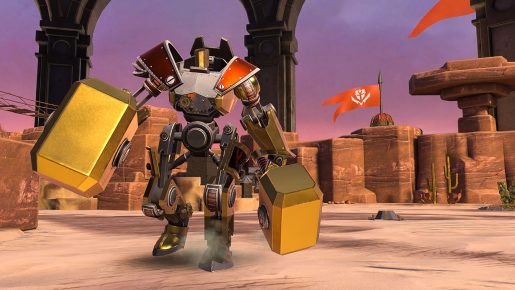[Editor’s Note: Since the review was published it has been brought to our attention by the developers that a coop mode (2 players vs AI) is now available, as are 6 different maps in Brass Tactics. Matchmaking is also based upon skill and experience, despite not visually showing a rank.]
Brass Tactics is a VR Real-Time Strategy game from Hidden Path Entertainment, known for the Defence Grid games and for being composed of developers who worked on the classic Age of Empires 2. The game is an Oculus exclusive so is only available on the Oculus store, and reportedly does not work well with the Vive through ReVive due to the control scheme not being designed for it. There is a free-to-play version, which essentially is a demo, called Brass Tactics: Arena which is definitely worth checking out before buying the full game. The Arena version includes pretty much the full multiplayer experience on one map, and the first level of the campaign which is effectively a tutorial.
The game map is presented as a tabletop, with stylised representations of terrain and troops very reminiscent of the Game of Thrones credits sequence. This strong style gives a lot of clarity, critical in an RTS, and is generally pretty amazing to look at in VR. The units themselves are very nicely detailed and animated, to the point where I often wanted to bring the tabletop up to eye level for a closer look.
The quality of presentation extends past the graphics though, particularly into the user interface. Controlling your troops is achieved by pointing at them, holding the trigger down to select them then pointing at where you want them to go and releasing the trigger. Half-pulling the trigger allows you to pick out a single unit from a group while holding the analogue stick up or down when you let the trigger go lets you give the order to attack, move or hold ground. All of this is very slick once you know what the control scheme is, but still doesn’t allow for quite the level of control you get in a traditional non-VR RTS using a mouse and keyboard. One unique and very satisfying advantage of the control scheme in Brass Tactics though is that you can simultaneously give an order with each hand due to the controls being ambidextrous. It really feels great to be able to synchronise attacks from different directions so easily.

There are two main resources to keep track of in the game: jewels and ore. Jewels are primarily used to construct buildings, whether they be towers on the map or upgrading buildings within your castle, while ore is used to train units. Both are obtained from mines dotted around the map and are tracked on the top of your hands so can always be easily checked; the jewel counter also gives you a timer until you next receive income which helps with planning.
Flipping your hands over shows you a palette of towers to construct, which also correspond to the unit types you have available. These have to be placed on nodes around the map which are unlocked by bringing a unit nearby; there are either one or two such nodes in each map region and ownership of the region is defined by who has towers built there. In addition to the main towers there are normally one or two smaller defensive slots there, which is achieved by reaching your hand out and pressing ‘A’ rather than grabbing a tower from the palette and dropping it into place like with the larger buildings.
The towers you build around the map are where you build troops from, of the type specified when you build the tower. These troops spawn around the tower as they are trained so the choice of what type to build where is an interesting one, and remains so even when you have access to all of your unit types as you’re effectively selecting which unit type you want to have access to quickly on the frontline.

In addition to the buildings you construct on the battlefield you also have a number to build inside your keep. These are pulled out from a drawer and provide upgrades, mostly to your units. You only have a limited number of slots to place these in so which upgrades you want to pursue is another important choice, particularly as a second tier of upgrades for each unit provides a choice of two specialisations which dramatically change the properties of the unit, like adding a stealth ability to warriors.
In multiplayer and skirmish you also need to decide on what units to include on your palette of eight available in-game from the twelve available, which along with selection of base and trim colours effectively builds your faction. In the campaign you don’t have this option, with new units instead being introduced gradually as you progress. This definitely gives the campaign the feel of being a tutorial, which is a fairly common approach in RTS games, but is particularly true of the first two levels which really are just tutorials which is a little disappointing given that those constitute a full quarter of the missions.
The campaign levels are fairly varied and interesting, and some good voice actors have been included but I still came away with no real investment in the world or narrative. The fact that the story is only really told though conversations between highly stylised avatars of characters at the start or end of a level is a big part of this, even if those conversations are often reasonably entertaining. It really does feel like the story is an afterthought though, which is a feeling compounded by the fact that once you finish a level you are unceremoniously dumped back to the main menu, with no prompt to continue the campaign. This is by no means a deal breaker but was a little jarring, particularly as the rest of the game presents itself so well. The campaign was also fairly short, taking me a little under three and a half hours to complete which should be borne in mind if you’re looking at this game to provide a solo experience.

As is often the case in RTS games the multiplayer is the real heart of the game. There is a good variety of maps to play on and in solo skirmish there are three different AI personalities to fight, all available at a variety of different difficulties. Cooperative play is also an option though as ever this is unlikely to be fulfilling unless you’ve got a friend available to play with, though matchmaking is included for it. Interestingly there is no ranking system included for multiplayer though the developer has clarified that there is skill-based matchmaking. As the game is already crunching the numbers it seems odd that no ranking is shown, as this would give the more avid players something to keep track of and work on; this isn’t too much of a problem now but might hurt longevity in the long-run.
All things considered Brass Tactics is the best RTS game for VR right now; compared to other offerings it retains much more of the depth and complexity which makes the genre so beloved by many. That said it doesn’t quite have the gameplay detail of the beloved giants of the genre in the non-VR space, and other niggles like the shortness of the campaign keep the game from true greatness. While it may not be remembered as fondly as Age of Empires 2 it will probably be remembered as the first RTS to really do VR right, and that’s still pretty good.
[Editor’s Note: Brass Tactics was provided to us by the developer for the review.]
